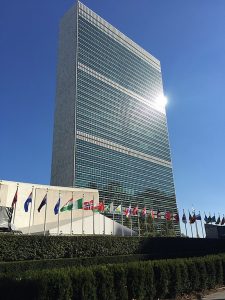Does the Sea Divide Us or Unite Us?
For more than seventy years, the United Nations has been the best effort to unify the world. Though imperfect, it continues to reinvent itself in a world with ever greater challenges.
In recent years, an important program at the U.N. has been the 17 Sustainable Development Goals, sometimes referred to as the “SDG’s” or Agenda 2030. They are a very worthy list of goals addressing poverty, safe water, gender equality, climate change, sustainable cities, etc. [For a full listing and description, see 17 SDG’s] Thousands of efforts are now underway to achieve these global goals.
 Yesterday at a United Nations event about the 17 Sustainable Development Goals I was honored with a “World Award” – recognizing advancement towards the goals. At the ceremony, my remarks were about how the sea unites and unifies us, picking up on the theme of the evening.
Yesterday at a United Nations event about the 17 Sustainable Development Goals I was honored with a “World Award” – recognizing advancement towards the goals. At the ceremony, my remarks were about how the sea unites and unifies us, picking up on the theme of the evening.
The usual view is that oceans divide nations. However, the oceans have also long been a vehicle to bring the world together in a way that is little appreciated. International agreements about shipping, fisheries, vessel safety, rescue operations, and pollution get cooperation and dialogue among nations that might otherwise not even have diplomatic relations. So that is a traditional way that the sea unifies the world.
In my remarks last night, I looked at the sea’s ability to unite us through a different lens. As my readers know, the sea has now started to rise, largely due to melting ice sheets in Greenland and Antarctica. Our warming world now ensures a considerable amount of sea level rise, as the vast ice sheets melt. Perhaps surprisingly, that could be a new reason for global cooperation.
Rising sea level will be quite egalitarian. It will affect rich and poor in both developed and developing areas. Of course the poor are likely to be hit hardest, often with few resources to move to higher ground.
Rising sea level does not just affect coastal nations. Even land-locked nations such as Switzerland rely on ports for shipping and global supply chains.
On a global scale, rising sea level will direct us to two efforts:
First, to do everything possible to slow the warming, generally focused on reducing carbon dioxide and other greenhouse gas emissions. (SDG#13).
Second, we need to invest in infrastructure and sustainable cities, SDG #9 and #11, respectively. But rising sea level raises the bar. We must begin planning and adapting now for an entirely new era ahead.
Though there is no simple solution for rising sea level, we must begin to invest in lasting adaptations. Different locations will need different approaches. The United Nations does provide a useful perspective on the opportunity to share best practices among such highly diverse nations.
The sea divides us and the sea unites us.
